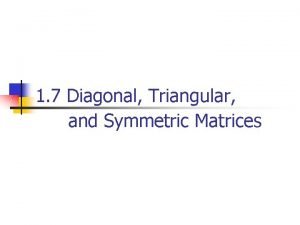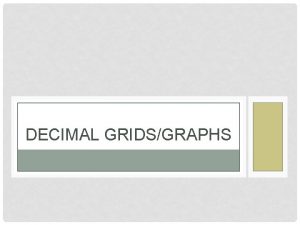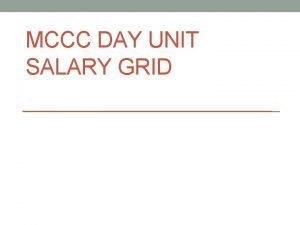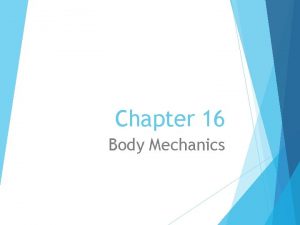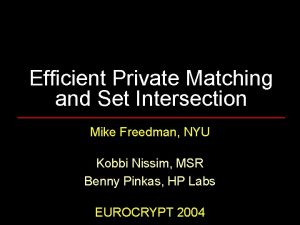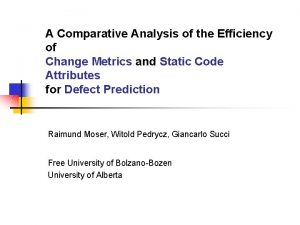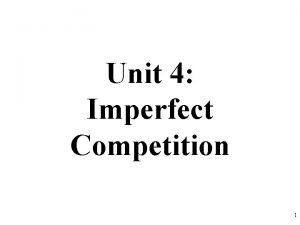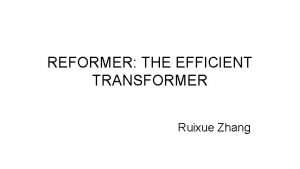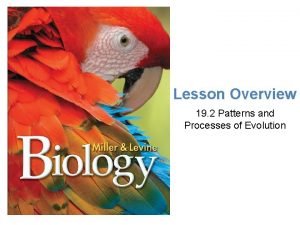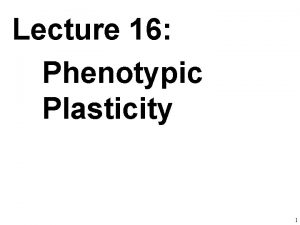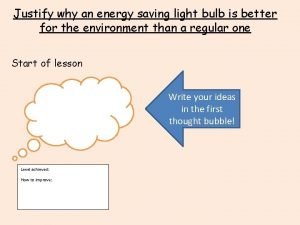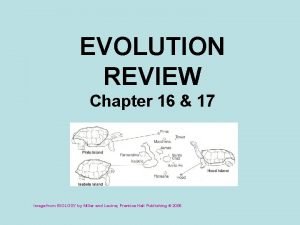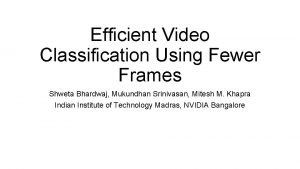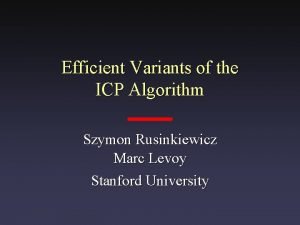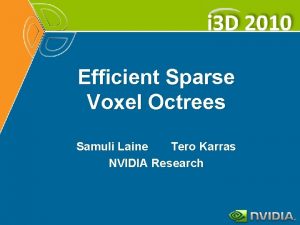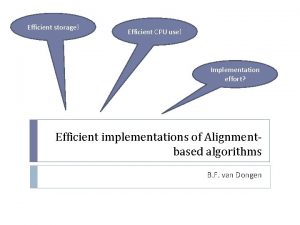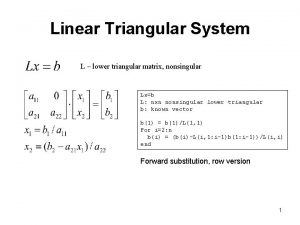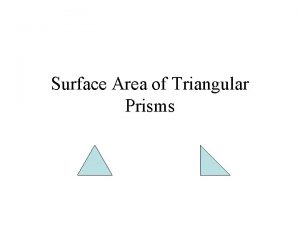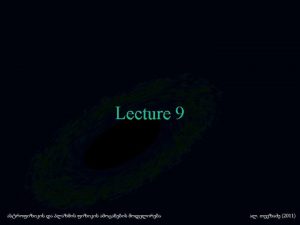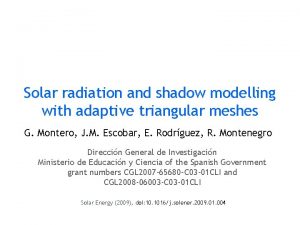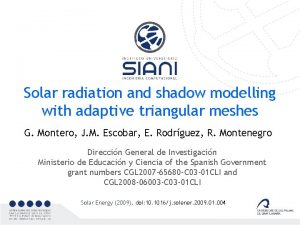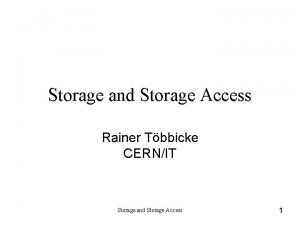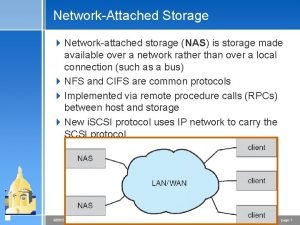Efficient Storage and Processing of Adaptive Triangular Grids












































































- Slides: 76

Efficient Storage and Processing of Adaptive Triangular Grids using Sierpinski Curves Csaba Attila Vigh Department of Informatics, TU München JASS 2006, course 2: Numerical Simulation: From Models to Visualizations

Outline • Adaptive Grids – Introduction and basic ideas • Space-Filling curves – Geometric generation – Hilbert’s, Peano’s, Sierpinski’s curve • Adaptive Triangular Grids – Generation and Efficient Processing • Extension to 3 D

Adaptive Grids – Basics • Why do we need Adaptive grids? • Modeling and Simulation – PDE – mathematical model – Discretization – Solution with Finite Elements or similar methods – Demand for Adaptive Refinement – very often

Adaptive Grids – Basics • Adaptive Refinement – Trade-off between Memory Requirements and Computing Time – Need to obtain Neighbor Relationships between Grid Cells – Storing Relationships Explicitly leads to: • Arbitrary Unstructured Grids • Considerable Memory Overhead

Adaptive Grids – Basics • Adaptive Refinement - want to save memory? – Use a Strongly Structured Grid – Use Recursive Splitting of Cells (Triangles) – Neighbor Relations must be computed – Computing Time should be small

Adaptive Grids – Basics • Processing of Recursively Refined (Triangular) Grid – Linearize Access to the Cells using Space. Filling Curves • For Triangles – Sierpinski Curve – Use a Stack System for Cache-Efficiency – Parallelization Strategies using Space-Filling Curves are readily available

Space-Filling Curves • 1878, Cantor – Any two Finite-Dimensional Manifolds have same Cardinality – [0, 1] can be Mapped Bijectively onto the Square [0, 1]x[0, 1], or onto the Cube • 1879, Netto – such a Mapping is necessarily Discontinuous

Space-Filling Curves • Is then possible to obtain a Surjective Continuous Mapping? or • Is there a Curve that passes through every Point of a Two-Dimensional Region? • 1890, Peano constructed the first one

Hilbert’s Space-Filling Curve • Hilbert’s Geometric Generating Process – If Interval I ( ) can be mapped continuously onto the square Q ( ) • Partition I into Four Congruent Subintervals • Partition Q into Four Congruent Subsquares – Then each Subinterval can be Mapped Continuously onto one of the Subsquares – Next continue the Partitioning Process on the Subintervals and Subsquares

Hilbert’s Space-Filling Curve • Hilbert’s Geometric Generating Process – After n Partitioning Steps I and Q are split into Congruent Replicas – Subsquares can be arranged such that • Adjacent Subintervals correspond to Adjacent Subsquares with an Edge in common • Inclusion Relationships are preserved

Hilbert’s Space-Filling Curve Hilbert’s Mapping and three Iterations

Hilbert’s Space-Filling Curve Six Iterations

Peano’s Space-Filling Curve • Partitioning in 9 Subintervals and Subsquares • Subintervals mapped to Subsquares Peano’s Mapping

Peano’s Space-Filling Curve Three Iterations of the Peano Curve

Sierpinski’s Space-Filling Curve Four Iterations of the Sierpinski Curve • Slicing the Square into half by its Diagonal • Half of the Curve lies on one Triangle • Other half lies on the other Triangle

Sierpinski’s Space-Filling Curve • Curve may be viewed as a Map from Unit Interval I onto a Right Isosceles Triangle T • T with Vertices at (0, 0), (2, 0), (1, 1) • Hilbert’s Generating Principle – Partition I into two Congruent Subintervals – Partition T into two Congruent Subtriangles – Order of Subtriangles shown in the next picture

Sierpinski’s Space-Filling Curve

Sierpinski’s Space-Filling Curve • Curve starts from (0, 0), ends at (2, 0) • Exit Point from each Subtriangle coincides with Entry Point of the next one • Requirement on Orientation in Subtriangles shown in picture below

Recursively Structured Triangular Grids and Sierpinski Curves – Computational Domain • Right Isosceles Triangle – Starting Cell – Grid constructed recursively • Split each Triangle Cell into 2 Congruent Subcells • Splitting Repeated until Desired Resolution is Reached • Grid may be Adaptive – Local Splitting

Recursively Structured Triangular Grids and Sierpinski Curves Recursive Construction of the Grid on a Triangular Domain

Recursively Structured Triangular Grids and Sierpinski Curves • Cells are in Linear Order on the Sierpinski Curve • Corresponds to Depth-First Traversal of the Substructuring Tree • Additional Memory 1 bit per Cell indicating whether – Cell is a Leave, or – Cell is Adaptively Refined

Recursively Structured Triangular Grids and Sierpinski Curves • Extensions for Flexibility – Several Initial Triangles may be used – Arbitrary Triangles may be used if • Structure of Recursive Subdivision preserved • One Leg is defined as Tagged Edge and will take the role of the Hypotenuse – Tagged Edge can be replaced by a Linear Interpolation of the Boundary (see next picture)

Recursively Structured Triangular Grids and Sierpinski Curves Subdividing Triangles at Boundaries

Discretization of the PDE • A Discretization with Linear FE – Generates • Element Stiffness Matrices • Right Hand Sides – Accumulates them into Global System of Equations for the Unknowns on the Nodes • We consider it to be too Memory Consuming

Discretization of the PDE • Assumption – Stiffness Matrix Computation possible on the fly, or – Hardcode it into the Software • Typical for Iterative Solvers – Contain Matrix-Vector Product between Stiffness Matrix and Unknowns • Memory used only for storing Grid Structure

Discretization of the PDE • Classical Node-Oriented Processing – Loop over Unknowns (Nodes on Grid) – Requires Access to all neighbor Nodes – Difficult in a Recursively Structured Grid – Neighbor could be on a Different Subtree • Our Approach: Cell-Oriented Processing

Cache Efficient Processing of the Computational Grid • Cell-Oriented Processing – Need Access to Unknowns for each Cell – Process Elements along the Sierpinski Curve • Sierpinski Curve Divides Unknowns into two halves – Left of the Curve: Red Nodes – Right of the Curve: Green Nodes – See picture next

Cache Efficient Processing of the Computational Grid Red (Circles), Green (Boxes)

Cache Efficient Processing of the Computational Grid • Access to Unknowns is like Access to a Stack • Consider Unknowns 5 to 10 – During Processing Cells to the Left – Access in Ascending Order – During Processing Cells to the Right – Access in Descending Order • Nodes 8, 9, 10 Placed in turn on Top of the Stack

Cache Efficient Processing of the Computational Grid • System of Four Stacks – to Organize Access to Unknowns – Read Stack holds Initial Value of Unknowns – Two Helper Stacks – Red and Green – hold Intermediate Values of Unknowns of respective Color – Write Stack stores Updated Values of Unknowns

Cache Efficient Processing of the Computational Grid • When Moving from one Cell to the other – 2 Unknowns Adjacent to Common Edge can always be reused – 2 Unknowns opposite to Common Edge must be processed: • One from Exited Cell • One in the New Cell

Cache Efficient Processing of the Computational Grid • Unknown from Exited Cell – Put onto Write Stack – if processing complete – Put onto Helper Stack of respective Color – if needed by other Cells • Unknown in the New Cell – Take from Read Stack – if never used it before – Take from Helper Stack of respective Color – if already used it before

Cache Efficient Processing of the Computational Grid • Unknown from Exited Cell – Count number of Accesses – Determine whether Processing is Complete or not – Determine the Color – Left or Right side of the Sierpinski Curve ? – Curve Enters and Exits at the 2 Nodes adjacent to the Hypotenuse – Only 3 possible Scenarios

Cache Efficient Processing of the Computational Grid • Determining Color of the Nodes 1. Curve Enters through Hypotenuse – Exits across Opposite Leg 2. Curve Enters through Adjacent Leg – Exits through Hypotenuse 3. Curve Enters and Exits across the Opposite Legs Red (circles), Green (boxes)

Cache Efficient Processing of the Computational Grid • Unknown in the New Cell – Determine Color as above – Determine whether New or Old • Consider the 3 Triangle Cells adjacent to “This Cell” • One is Old – where the Curve entered • One is New – where the Curve exits • Third Cell may be Old or New – check Adjacent Edges – Both New Third Cell is New Unknown is New – Unknown is Old otherwise

Cache Efficient Processing of the Computational Grid • Recursive Propagation of Edge Parameters • Knowing Scenario for the Cell also know Scenarios for Subcells

Cache Efficient Processing of the Computational Grid • Processing of the Grid is managed by a set of 6 Recursive Procedures • On the Leaves the Discretization-Level Operations are performed • Example from Maple worksheet is next

Step 1

Step 2

Step 3

Step 4

Step 5

Step 6

Step 7

Step 8

Step 9

Step 10

Step 11

Step 12

Step 13

Step 14

Step 15

Step 16

Step 17

Step 18

Step 19

Step 20

Step 21

Step 22

Step 23

Step 24

Step 25

Step 26

Step 27

Step 28

Step 29

Step 30

Step 31

Step 32

Parallelization – 5 Equal parts

Conformity of Locally Refined Grids • No hanging Nodes • Maintaining Conformity in any Locally Refined Grid – Consider Triangles, Tetrahedrons or NSimplices Refined with Recursive Bisections – Need only Finite Number of Additional Bisections for Completion – Locality of Refinement is preserved – Grid will not become Globally Uniformly Refined

3 D Sierpinski Curves • • 2 D Sierpinski Curve fills a Triangle 3 D Curve expected to fill a Tetrahedron How to subdivide a Tetrahedron? Tetrahedron with a Tagged Edge: – 4 -Tuple – Edge with is • Directed • Tagged • Takes the role of the Hypotenuse

3 D Sierpinski Curves • Bisection of Tetrahedron along Tagged Edge , • Sierpinski Curve Approximated by Polygonal Line of the Tagged Edges

3 D Sierpinski Curves Bisection of a Tagged Tetrahedron. Red Arrows approximate the Sierpinski Curve.

Conclusion • Algorithm Efficiently generates and processes Adaptive Triangular Grids • Memory Requirement is minimal • Hope to achieve Computational Speed competitive with Algorithms based on Regular Grids • Extension to 3 D is currently subject to research

Questions? ? Thank You!
 Productively efficient vs allocatively efficient
Productively efficient vs allocatively efficient Productively efficient vs allocatively efficient
Productively efficient vs allocatively efficient Productively efficient vs allocatively efficient
Productively efficient vs allocatively efficient Productively efficient vs allocatively efficient
Productively efficient vs allocatively efficient Allocative efficiency vs productive efficiency
Allocative efficiency vs productive efficiency Layered architecture for web services and grids
Layered architecture for web services and grids Diagonal matrix multiplication
Diagonal matrix multiplication Off focus grid error
Off focus grid error Glow discharge tem
Glow discharge tem Decimal using grids
Decimal using grids Grids 49152
Grids 49152 Demand response in smart grids
Demand response in smart grids Mccc salary grid
Mccc salary grid Bootstrap 4 grids
Bootstrap 4 grids Differentiation grids
Differentiation grids Efficient processing of deep neural networks
Efficient processing of deep neural networks What is the role of eddy in adaptive query processing
What is the role of eddy in adaptive query processing Primary storage vs secondary storage
Primary storage vs secondary storage Primary storage and secondary storage
Primary storage and secondary storage How to find volume of a triangular prism
How to find volume of a triangular prism Secondary storage provides temporary or volatile storage
Secondary storage provides temporary or volatile storage Unified storage vs traditional storage
Unified storage vs traditional storage Neighborhood processing in image processing
Neighborhood processing in image processing What is secondary processing
What is secondary processing Batch processing vs interactive processing
Batch processing vs interactive processing Bottom up processing
Bottom up processing Bottom up processing vs top down processing
Bottom up processing vs top down processing Bottom up and top down processing
Bottom up and top down processing Image enhancement by point processing
Image enhancement by point processing Histogram processing in digital image processing
Histogram processing in digital image processing Parallel processing vs concurrent processing
Parallel processing vs concurrent processing Neighborhood processing in digital image processing
Neighborhood processing in digital image processing پردازش تصویر
پردازش تصویر Morphological
Morphological Bottom up vs top down processing
Bottom up vs top down processing Effective and efficient example
Effective and efficient example Anita archer explicit instruction
Anita archer explicit instruction Using the body in an efficient and careful way
Using the body in an efficient and careful way Modifiers for comparison
Modifiers for comparison Efficient private matching and set intersection
Efficient private matching and set intersection Abilities for adaptive and positive behavior
Abilities for adaptive and positive behavior Miles and snow's adaptive strategies
Miles and snow's adaptive strategies Adaptive maintenance
Adaptive maintenance Efficient capital markets and behavioral challenges
Efficient capital markets and behavioral challenges Efficient and equitable taxation
Efficient and equitable taxation Efficient, transparent, and equitable
Efficient, transparent, and equitable Comparative and superlative efficient
Comparative and superlative efficient A pericardiophrenica
A pericardiophrenica Efficient and flexible reading
Efficient and flexible reading Efficient comparative and superlative
Efficient comparative and superlative Warehouse objectives
Warehouse objectives Socially efficient quantity
Socially efficient quantity Adaptive plasticity
Adaptive plasticity Evidence supporting efficient market hypothesis
Evidence supporting efficient market hypothesis Adaptive maintenance in software engineering
Adaptive maintenance in software engineering Software maintenance cost factors
Software maintenance cost factors Dsdm models
Dsdm models Adaptive leadership style
Adaptive leadership style Reformer: the efficient transformer
Reformer: the efficient transformer Linda r greene
Linda r greene Adaptive focused acoustics
Adaptive focused acoustics Patterns of evolution
Patterns of evolution Adaptive plasticity
Adaptive plasticity Led light bulb sankey diagram
Led light bulb sankey diagram Dynamic adaptive streaming over http implementation
Dynamic adaptive streaming over http implementation Adaptive challenge example
Adaptive challenge example Is adaptive radiation divergent evolution
Is adaptive radiation divergent evolution Divergent evolution vs adaptive radiation
Divergent evolution vs adaptive radiation Types of natural selection
Types of natural selection Efficient video classification using fewer frames
Efficient video classification using fewer frames Efficient variants of the icp algorithm
Efficient variants of the icp algorithm Efficient variants of the icp algorithm
Efficient variants of the icp algorithm Tero karras
Tero karras Efficient market hypothesis
Efficient market hypothesis Efficient market hypothesis
Efficient market hypothesis Four h group details
Four h group details Efficient elements powerpoint
Efficient elements powerpoint






